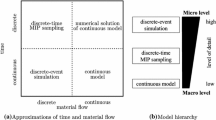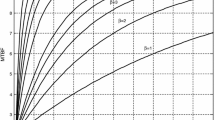Abstract
We consider production lines consisting of a series of machines separated by finite buffers. The processing time of each machine is deterministic and all the machines have the same processing time. All machines are subject to failures. As is usually the case for production systems we assume that the failures are operation dependent [3,7]. Moreover, we assume that the times to failure and the repair times are exponentially distributed. To analyze such systems, a decomposition method was proposed by Gershwin [13]. The computational efficiency of this method was later significantly improved by the introduction of the so‐called DDX algorithm [5,6]. In general, this method provides fairly accurate results. There are, however, cases for which the accuracy of this decomposition method may not be acceptable. This is the case when the reliability parameters (average failure time and average repair time) of the different machines have different orders of magnitude. Such a situation may be encountered in real production lines. In [8], an improvement of Gershwin's original decomposition method has been proposed that in general provides more accurate results in the above mentioned situation. This other method is referred to as the Generalized Exponential (GE) method. The basic difference between the GE‐method and that of Gershwin is that it uses a two‐moment approximation instead of a single‐moment approximation of the repair time distributions of the equivalent machines. There are, however, still cases for which the accuracy of the GE‐method is not as good as expected. This is the case, for example, when the buffer sizes are too small in comparison with the average repair time. We present in this paper a new decomposition method that is based on a better approximation of the repair time distributions. This method uses a three‐moment approximation of the repair time distributions of the equivalent machines. Numerical results show that the new method is very robust in the sense that it seems to provide accurate results in all situations.
Similar content being viewed by others
References
R. Alvarez, Y. Dallery and R. David, A study of the continuous flow model of production lines with unreliable machines and finite buffers, Journal of Manufacturing Systems 13(3) 221–234.
J.A. Buzacott, Automatic transfer lines with buffer stocks, Int. J. Prod. Res. 5(3) (1967) 182–200.
J.A. Buzacott and L.E. Hanifin, Models of automatic transfer lines with inventory banks: a review and comparison, AIIE Transactions 10(2) (1978) 197–207.
Y. Dallery, On modeling failure and repair times in stochastic models of manufacturing systems using generalized exponential distributions, Queueing Systems 15 (1994) 199–209.
Y. Dallery, R. David and X.L. Xie, An efficient algorithm for analysis of transfer lines with unreliable machines and finite buffers, IIE Transactions 20 (1988) 280–283.
Y. Dallery, R. David and X.-L. Xie, Approximate analysis of transfer lines with unreliable machines and finite buffers, IEEE Transactions on Automatic Control 34(9) (1989) 943–953.
Y. Dallery and S.B. Gershwin,Manufacturing flow line systems: a review of models and analytical results, Queueing Systems 12 (1992) 3–94.
Y. Dallery and H. Le Bihan, An improved decomposition method for the analysis of production lines with unreliable machines and finite buffers, International Journal of Production Research 37(5) (1999) 1093–1117.
Y. Dallery and H. Le Bihan, Homogenisation techniques for the analysis of production lines with unreliable machines having different speeds, European Journal of Control 3 (1997) 200–215.
M. Di Mascolo, R. David and Y. Dallery, Modeling and analysis of assembly systems with unreliable machines and finite buffers, IIE Transactions 13(4) (1991) 315–330.
D. Dubois and J.-P. Forestier, Productivit´e et en-cours moyens d'un ensemble de deux machines s´epar´ees par une zône de stockage, RAIRO Automatique 16(2) (1982) 105–132.
Y. Frein, C. Commault and Y. Dallery, Modeling and analysis of closed-loop production lines with unreliable machines and finite buffers, IIE Transactions 28 (1996) 545–554.
S.B. Gershwin, An efficient decomposition method for the approximate evaluation of tandem queues with finite storage space and blocking, Operations Research 35(2) (1987) 291–305.
S.B. Gershwin and I.C. Schick, Continuous model of an unreliable two-stage material flow system with a finite interstage buffer, Tech. Rep. LIDS-R-1039, Massachusetts Institute of Technology (1980).
S.B. Gershwin and I.C. Schick, Modelling and analysis of three-stage transfer lines with unreliable machines and finite buffers, Operations Research 31(2) (1983) 354–380.
S.B. Gershwin and T. Tolio, Deterministic two-machine lines with multiple failure modes, Internal report N_ 15–96 Politecnico di Milano Department of Mechanical Engineering (1996).
D.D. Kouvatsos, Maximum entropy and the G=G=1=N queue, Acta Informatica 23 (1986) 545–565.
H. Le Bihan, De nouvelles m´ethodes analytiques pour l'´evaluation de performances de lignes de production, Ph.D. thesis, Universit´e Pierre et Marie Curie (1998).
H. Le Bihan and Y. Dallery, Analysis of the continuous flow model of a two-machine production line with exponential failure time and hyper-exponential repair time distribution, Technical report LIP6, in preparation.
E. Olivi, Rapport de Stage, Technical Report ARD/DT-114, P´echiney.
T. Tolio and A. Matta, A method for performance evaluation of automated flow lines, CIRP Annals 47/1 (1998).
S. Yeralan, W.E. Franck Jr. and M.A. Quasem, A continuous materials flow production line model with station breakdown, European Journal of Operational Research 27 (1986) 289–300.
B. Zimmern, Etude de la propagation des arrêts al´eatoires dans les chaînes de production, Revue de Statistique Appliqu´ees 4 (1956) 85–104.
Author information
Authors and Affiliations
Rights and permissions
About this article
Cite this article
Le Bihan, H., Dallery, Y. A robust decomposition method for the analysis of production lines with unreliable machines and finite buffers. Annals of Operations Research 93, 265–297 (2000). https://doi.org/10.1023/A:1018996428429
Issue Date:
DOI: https://doi.org/10.1023/A:1018996428429




